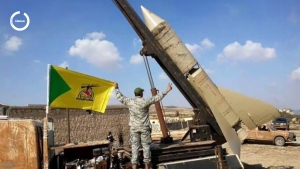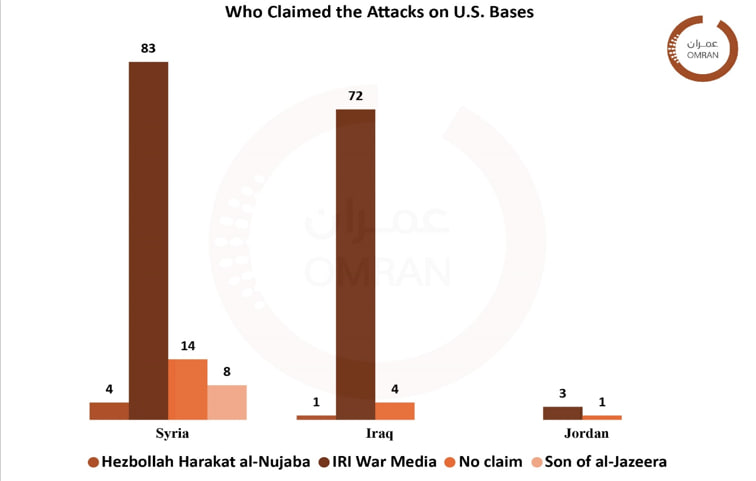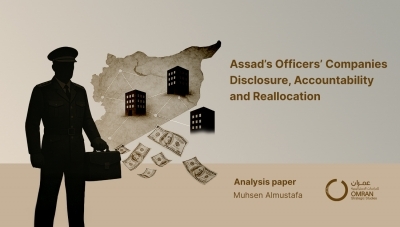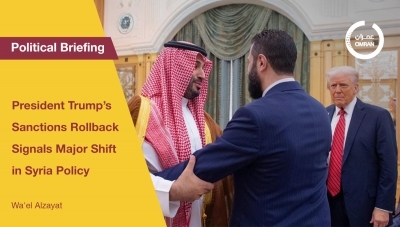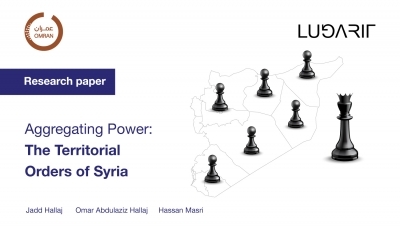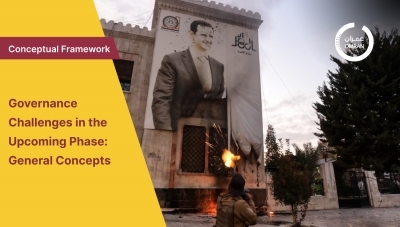Events
Analyzing Iranian-Orchestrated Attacks on U.S. Bases in Syria and Iraq Post Gaza War
Introduction
The landscape of Middle Eastern conflict underwent a notable evolution in the aftermath of the Gaza War, with the Islamic Resistance in Iraq (IRI) emerging as a significant player in the matrix of Iranian-backed military operations. This report scrutinizes the pattern of IRI-initiated strikes on U.S. installations in Syria and Iraq and evaluates the corresponding U.S. military responses within the framework of the broader geopolitical contest that unfolded post the Gaza War.
The data compiled within this document have been meticulously sourced from the following authoritative resources:
1. Official Statements and Bulletins: Data was sourced directly from the Islamic Resistance in Iraq's official Telegram channels, associated Popular Mobilization Units (PMU) factions, formal press releases from the United States, and attack chronologies developed by Dr. Hamid Hamed, a recognized expert on IRGC and PMU activities in the region(1).
2. Strikes Specifics: Detailed strike coordination’s were obtained by the author of the report using ArcGIS.
3. Report Visual: Map, Charts, Data Tables, were created by the author of the report using ArcGis, Power Pi, and Adobe Illustrator.
The Emergence of the Islamic Resistance in Iraq: Coordination and Operations
The term “Islamic Resistance in Iraq” first came to prominence following the 2003 U.S. invasion of Iraq, initially serving as an umbrella term for various Sunni armed factions known for their production of visual media and official statements. This collective identity waned as Shiite militant groups, backed by Iran, gained dominance. On October 21, 2023, the “Islamic Resistance in Iraq” reemerged in the spotlight when armed factions under this banner executed missile and drone strikes on U.S. military installations in Syria and Iraq. These attacks were a direct response to the Israeli offensive in the Gaza Strip in October 2023, which received U.S. support.
Unlike its initial formation in 2003, the reconstituted Islamic Resistance in Iraq, also referred to as Al-Muqawama al-Islamiyah fi al-Iraq, has evolved into a formidable coalition of militias with deep ties to Iran. Operating actively within Iraq and extending its influence into Syria, this alliance has become a pivotal force in the regional geopolitical arena. It challenges U.S. interests and presence through a sophisticated network of operations, employing military tactics to assert its influence and achieve its objectives across the Middle East(2). During the October 2023 conflict between Israel and Hamas, the Islamic Resistance in Iraq demonstrated its strategic capabilities and intentions by launching coordinated strikes against U.S.-aligned targets. These operations underscored the coalition's role as a significant actor in the broader regional conflict, capable of conducting complex military actions across borders. The group's involvement in these strikes aligns with Iran's regional goals and its commitment to countering U.S. military influence and policies in the Middle East.
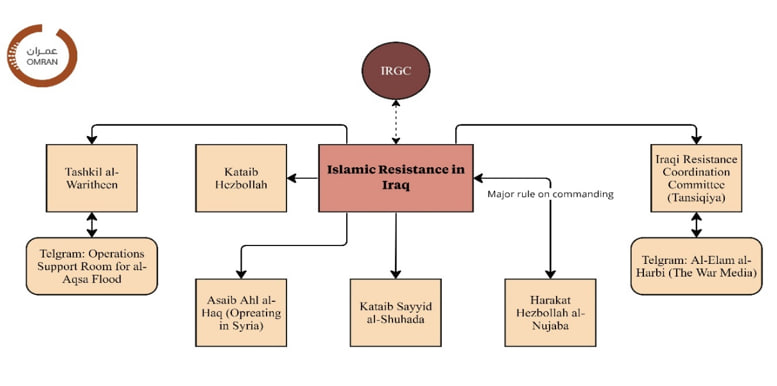
Figure (1): Islamic Resistance in Iraq Structure at the Time of Formation
The Islamic Resistance in Iraq's command structure showcases an advanced level of organization and coordination, significantly influenced by the Islamic Revolutionary Guard Corps-Qods Force (IRGC-QF), the IRGC-QF plays a crucial role in orchestrating the activities of the coalition, bringing together various Iraqi militia groups under a unified command for strategic purposes (3).
The strategic operations carried out by the coalition during this period were characterized by their high degree of coordination and sophistication, highlighting the group's ability to mobilize and execute military strategies effectively. These actions were not only aimed at challenging U.S. interests in the region but also demonstrated the coalition's capacity for significant military engagement. The ability of the coalition to extend its operations to Syria further exemplifies its broad reach and the transnational nature of its objectives.
The adoption of the “Islamic Resistance in Iraq” as a collective term is particularly noteworthy, echoing the nomenclature historically used by Iran-backed Iraqi armed groups. This branding strategy not only strengthens the collective identity of these militias but also acts as a unifying label that embodies their shared ethos of resistance. Prominent groups within the coalition, such as Kataib Hezbollah, Asaib Ahl al-Haq, and Kataib Sayyid al-Shuhada, have refrained from claiming separate operations within their usual areas of influence. This suggests a strong sense of unity within the coalition, emphasizing its role as a comprehensive representation of Iran-backed resistance efforts in Iraq (4).
Overview of Attacks Against U.S. Bases in Syria and Iraq by the IRI
Between October 18, 2023, and February 28, 2024, a total of /190/ attacks were reported against U.S. military bases in Syria and Iraq. The Islamic Resistance in Iraq (IRI) claimed responsibility for the majority of these incidents, showcasing a blend of conventional and innovative tactics in their operations. The group's arsenal featured medium-range missiles (al-Aqsa 1), drones (Qasef-2K/Shahed 101), and suicide drones, reflecting a strategic evolution and experimentation in their approach to combat. While the bulk of these assaults took place in Iraq and Syria, a handful were also recorded in Jordan, targeting vital strategic assets such as airbases, oil fields, and critical locations housing U.S. forces. These sites, heavily fortified with advanced defense mechanisms and artillery, underscore the strategic significance of the targets chosen by the IRI.
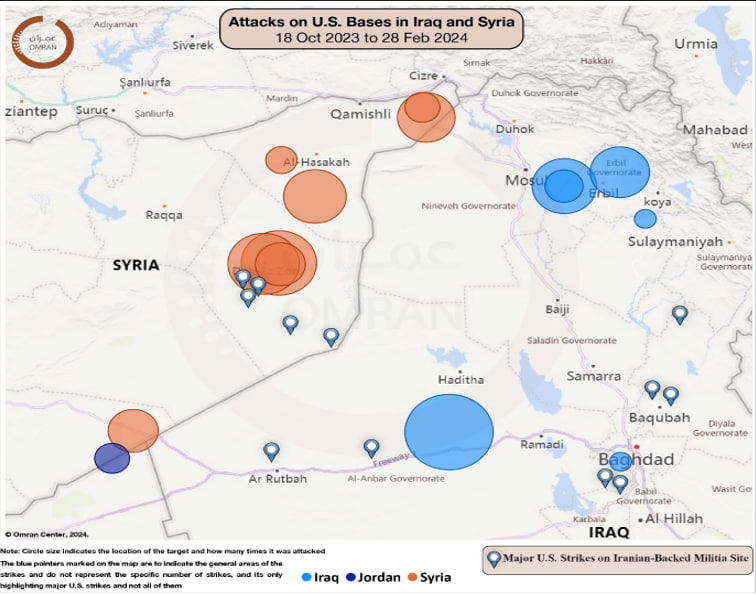
Map (1): Locations of the Attacks on U.S. Bases in Syria, Iraq, and Jordan – 18 Oct 2023 to 28 Feb 2024
Post-Gaza War Attacks on U.S. Bases
In the aftermath of the Gaza conflict, the IRI launched its initial assault on October 18, 2023, executing simultaneous strikes on the Ain Asad Airbase and the Harir US Base in Iraq. The Ain Asad Airbase emerged as a focal point, enduring /37/ documented attacks. The Harir US Base and Erbil Airport also ranked high on the IRI's target list, suffering /15/ and /5/ attacks, respectively. The IRI's tactics were marked by diversity and sophistication, employing Iranian-manufactured drones, artillery, and long-range missiles to execute their strategic objectives(5-6-7) Shifting focus to Syria, the al-Omar Oil Field and Conoco Gas Field were subjected to a combined total of /49/ attack. This strategic focus on targeting facilities near the border between the Syrian Democratic Forces (SDF) and areas controlled by the Syrian regime “Area of Iran high presence and influence” in Deir Ezzor highlights the IRI's strategic priorities. Military bases such as the Shadadi US Base and the al-Tanf US Base were also significantly targeted, receiving /17/ and /10/ attacks, respectively, further emphasizing the strategic pattern of the IRI's operations across the region. A detailed breakdown of the targets can be found in the Appendix.
This period of heightened activity by the IRI against U.S. bases in Syria and Iraq not only demonstrates the group's operational capabilities and strategic intent but also highlights the evolving landscape of military engagement in the region, with implications for both regional stability and international security dynamics.
| WK No. | Year | Start Date | End Date | Total Attacks by Week | %Attacks by Week | Total Attacks by Month | %Attacks by Month | Attacks in Syria | Attacks in Jordan | Attacks in Iraq |
| WK42 | 2023 | 18-10-23 | 24-10-23 | 13 | 7% | 28 | 15% | 4 | 1 | 8 |
| WK43 | 2023 | 25-10-23 | 31-10-23 | 15 | 8% | 10 | 0 | 5 | ||
| WK44 | 2023 | 01-11-23 | 07-11-23 | 20 | 11% | 51 | 27% | 14 | 0 | 6 |
| WK45 | 2023 | 08-11-23 | 14-11-23 | 15 | 8% | 11 | 0 | 4 | ||
| WK46 | 2023 | 15-11-23 | 21-11-23 | 9 | 5% | 3 | 0 | 6 | ||
| WK47 | 2023 | 22-11-23 | 28-11-23 | 7 | 4% | 2 | 0 | 5 | ||
| WK48 | 2023 | 29-11-23 | 05-12-23 | 4 | 2% | 48 | 24% | 2 | 0 | 2 |
| WK49 | 2023 | 06-12-23 | 12-12-23 | 16 | 9% | 9 | 0 | 7 | ||
| WK50 | 2023 | 13-12-23 | 19-12-23 | 9 | 5% | 7 | 1 | 1 | ||
| WK51 | 2023 | 20-12-23 | 26-12-23 | 4 | 2% | 2 | 0 | 2 | ||
| WK52 | 2023 | 27-12-23 | 02-01-24 | 15 | 8% | 8 | 0 | 7 | ||
| WK01 | 2024 | 03-01-24 | 09-01-24 | 10 | 5% | 47 | 26% | 7 | 1 | 2 |
| WK02 | 2024 | 10-01-24 | 16-01-24 | 12 | 6% | 6 | 0 | 6 | ||
| WK03 | 2024 | 17-01-24 | 23-01-24 | 8 | 4% | 4 | 0 | 4 | ||
| WK04 | 2024 | 24-01-24 | 30-01-24 | 17 | 9% | 8 | 1 | 8 | ||
| WK05 | 2024 | 31-01-24 | 05-02-24 | 4 | 2% | 16 | 8% | 2 | 0 | 2 |
| WK06 | 2024 | 06-02-24 | 12-02-24 | 6 | 3% | 6 | 0 | 0 | ||
| WK07 | 2024 | 13-02-24 | 19-02-24 | 3 | 2% | 3 | 0 | 0 | ||
| WK08 | 2024 | 20-02-24 | 28-02-24 | 3 | 2% | 0 | 0 | 0 | ||
| 190 | 109 | 4 | 77 | |||||||
| 57% | 2% | 41% |
Table (1): IRI Attacks Breakdown 18 October 2023 to 28 February 2024
Strategic Dynamics and Retaliatory Patterns in U.S.-IRI Conflict: A Timeline Analysis
Late October to Mid-November 2023: Retaliatory Dynamics in Deir Ezzor
The initiation of U.S. strikes on October 27, followed by further actions on October 30 and November 9, 2023, marks a period of increased military activity, notably during weeks 42 to 45. This escalation aligns with the visit of the U.S. Secretary of State on November 5, suggesting a deliberate pattern of engagement and possibly an effort to demonstrate U.S. determination. The temporal correlation between these U.S. military operations and the surge in attacks indicates a retaliatory dynamic, highlighting the conflict's reactive nature, where U.S. actions prompt immediate countermeasures by opposing factions.
December 2023 to January 2024: Escalation Following U.S. Airstrikes
A NOTICEABLE INCREASE IN ATTACKS IN WEEK 49 AND CONTINUING INTO EARLY JANUARY 2024 CORRELATES WITH U.S. AIRSTRIKES ON DECEMBER 23 AND SUBSEQUENT JANUARY OPERATIONS TARGETING NUJABA ATTACK CELLS AND THEIR LEADERS. THIS PATTERN SUGGESTS A CYCLE OF REPRISAL FOLLOWING U.S. MILITARY INTERVENTIONS. THE FLUCTUATING ATTACK RATES IN RESPONSE TO U.S. ACTIONS REVEAL A CONTINUOUS LOOP OF ACTION AND RETALIATION, EMPHASIZING THE DIFFICULTY OF SECURING A LASTING DE-ESCALATION THROUGH MILITARY MEANS ALONE.
Late January 2024: The Rukban (Tower 22) Attack and Its Aftermath
THE SIGNIFICANT UPTICK IN ATTACKS DURING WEEK 04, CULMINATING IN THE RUKBAN ATTACK ON JANUARY 28 THAT RESULTED IN SEVERAL U.S. CASUALTIES, FOLLOWED BY KATAIB HEZBOLLAH'S SUSPENSION OF ATTACKS ON JANUARY 30, REPRESENTS A CRITICAL JUNCTURE. THIS PAUSE IN HOSTILITIES MAY HAVE CONTRIBUTED TO A DECREASE IN ATTACKS AGAINST U.S. BASES, AS OBSERVED IN THE SUBSEQUENT REDUCTION IN WEEK 05. THIS SERIES OF EVENTS UNDERSCORES THE INTRICATE RELATIONSHIP BETWEEN DIRECT CONFRONTATIONS WITH CASUALTIES AND THE STRATEGIC DECISIONS BY MILITANT GROUPS TO TEMPORARILY CEASE OPERATIONS, EITHER FOR REASSESSMENT OR AS A TACTICAL PAUSE IN ANTICIPATION OF THE U.S. RESPONSE TO THE (TOWER 22) INCIDENT.
Early February 2024: U.S. Airstrikes and Strategic Implications
In early February 2024, the United States launched airstrikes on over /90/ locations in Syria and Iraq, targeting the operational capabilities of Iran-backed militias. Among the key figures targeted were two commanders from Harakat Hezbollah al-Nujaba, including the military operations director, Abu Baqr al-Saeedi. These actions are part of a broader U.S. strategy aimed at countering Iranian influence and militia activities in the Middle East, reflecting the intricate balance of military power, strategic interests, and regional dynamics. The U.S. justified these strikes as self-defense measures to protect its forces from Iranian-backed group attacks, emphasizing a focus on terrorist entities supported by the IRGC and avoiding Iraqi state forces to minimize collateral damage and prevent an escalation with Iraqi authorities.
Late February 2024: Strategic Pause by Militant Groups
A significant development occurred when Akram al-Kaabi, the General Secretary of al-Nujaba within the Popular Mobilization Forces and the Islamic Resistance in Iraq, announced a temporary cessation of hostilities against U.S. bases by his group and other IRI factions. This pause, described as a tactical repositioning rather than an end to hostilities, indicates a strategic recalibration by the militias in response to U.S. military pressure. This move suggests a nuanced interplay of tactics, signaling, and strategic adjustments by both U.S. forces and Iranian-backed groups, highlighting the ongoing complexity and unpredictability of the regional security landscape (8).
Pattern of the Attacks: IRI's Leading Role in Targeting U.S. Bases
Between October 18, 2023, and February 28, 2024, U.S. military bases located in Syria, Iraq, and Jordan were subjected to a total of /190/ attack. The IRI has been identified as the primary perpetrator, claiming responsibility for /158/ of these incidents. This represents approximately 83% of the total attacks, highlighting the IRI's dominant operational presence and its aggressive posture towards U.S. forces in the region. Additionally, Hezbollah al-Nujaba has acknowledged their role in /5/ specific events, which accounts for nearly 3% of the overall attacks. These targeted operations by Hezbollah al-Nujaba were reportedly in direct retaliation to U.S. strikes on their leadership and facilities.
The emergence of the “Son of Al-Jazeera” armed group, responsible for /8/ attacks or about 4% of the total during this period, marks a notable development. Although their involvement is relatively minor, these attacks were distinctly aimed at SDF personnel at U.S. bases or checkpoints within Deir Ezzor. Insights from sources in Deir Ezzor suggest that these incidents are linked to the ongoing tensions between Arab tribes and SDF/Asayish forces in the region. The volatile security environment, further destabilized by the IRI's actions, has led to several significant assaults, particularly near the Al-Omar oil field and Conoco gas field in Deir Ezzor, resulting in numerous SDF casualties.(9) However, /19/ incidents, accounting for 10% of the total, remain unclaimed. The absence of attribution for these attacks might reflect a strategic choice by certain groups to maintain operational secrecy or a deliberate decision to avoid recognition to prevent potential retaliatory or political consequences (10).
Chart (1): Analyzing Responsibility for Attacks on U.S. Bases - 18 October 2023 to 28 February 2024
Overall Implication and Strategic Assessment
The intricate geopolitical landscape of the Middle East, marked by the Islamic Resistance in Iraq's (IRI) calculated strikes on U.S. interests, showcases a nuanced Iranian strategy of employing proxy groups to extend its sphere of influence across the region. From October 2023 to January 2024, the IRI's assertive military operations have underscored its pivotal role within Iran's broader strategy of exerting pressure across the Middle East. This approach mirrors the tactics of other Iranian-backed militias in southern Syria against northern Israel, Hezbollah's activities in the same area, and the Houthi campaigns in Yemen and against Israeli targets. The synchronized efforts of these proxies, under Tehran's direction, represent a multifaceted campaign aimed at bolstering Iran's bargaining position against the United States. The uniformity of these operations across various fronts highlights a coherent Iranian strategy designed to project power and gain leverage(11).
In response, the United States has adopted a containment strategy aimed at mitigating IRI attacks and curbing broader Iranian influence, favoring management of regional tensions over escalation. This measured military response reflects a strategic choice to maintain the status quo while avoiding the onset of a larger conflict that neither the U.S. nor Iran desires. (12) The U.S. strategy extends beyond direct military engagements to include collaborative efforts with regional allies. From October 7, 2023, to March 5, 2024, Israel executed /41/ strikes on Iran-affiliated targets, significantly undermining their operational capabilities. These operations resulted in the destruction of several key locations and the assassination of /15/ high-ranking IRGC commanders, with the IRGC's War-Media unit confirming the deaths of /10/ of these figures. Moreover, Jordan's initiatives against armed groups in southern Syria, alongside joint UK-U.S. operations targeting the Houthis in Yemen, play a crucial role in the overarching U.S. strategy to counter Iranian influence in the region. These collaborative actions underscore a comprehensive approach to mitigating the challenges posed by Iran and its proxies, emphasizing the importance of international partnerships in addressing regional security concerns (13-14).
This multilateral approach underscores a concerted effort to challenge Iranian interests from multiple angles, thereby bolstering the effectiveness of U.S. containment strategies. Through both independent and coordinated actions, a comprehensive U.S.-led initiative aims to limit Iranian expansion without precipitating a wider conflict. In this complex environment, both Iran and the U.S. leverage their respective alliances and capabilities to exert influence and secure advantages, setting the stage for a potential return to diplomatic negotiations. Both nations, recognizing the risks of escalating a sustained pressure campaign into a more significant conflict, seem inclined towards dialogue. This strategic perspective acknowledges that while pressure tactics can be maintained temporarily, they do not serve the long-term interests of either party and pose the risk of sparking a broader confrontation that both sides are eager to avoid.
Conclusion
In summary, the activities of the Islamic Resistance in Iraq (IRI) from October 2023 to February 2024 mark a critical juncture in the geopolitical landscape of the Middle East, characterized by a nuanced blend of military actions, strategic positioning, and diplomatic efforts. The IRI's bold initiatives, including numerous attacks on U.S. interests and its synergy with Iran's regional goals, underscore its pivotal role in the complex geopolitical tapestry of the Middle East. These events not only pose challenges to the U.S.'s strategic interests in the region but also mirror the larger power struggle between the U.S. and Iran, a contest played out through proxy groups and tactical military engagements.
The IRI's advanced organizational structure, strategic operations, and unified branding as a resistance movement reflect a deliberate strategy of military and political engagement. This strategy is emblematic of Iran's broader aim to utilize proxy forces as tools of regional dominance, seeking to assert influence and gain strategic advantages over the United States. The sequence of assaults followed by U.S. and allied counteractions highlights a persistent cycle of action and reaction, emphasizing the difficulties in securing enduring peace and stability in the region solely through military means.
This era of heightened conflict and strategic interaction between the IRI, the U.S., and their allies accentuates the need for a comprehensive approach that goes beyond conventional military responses. Such an approach must integrate diplomatic initiatives, political solutions, and regional collaborations to adeptly address the multifaceted challenges facing the Middle East. The primary objective should be to de-escalate tensions, avert a wider conflict, and strive for a lasting peace that tackles the root causes of the ongoing cycle of violence and retribution. The events spanning late 2023 to early 2024 serve as a vivid reminder of the delicate power equilibrium in the region and the paramount importance of strategic diplomacy in reducing the risk of further escalations and ensuring long-term stability.
([1]) Islamic Resistance in Iraq and other affiliations accounts on Telegram Platform. (To better understand how the present any positive/negative developments for their followers)
([2]) The Islamic Resistance in Iraq...a coalition of armed groups to support the “Al-Aqsa Flood”, 5 February 2024. Al-Jazzera https://shorturl.at/gmqL8
([3]) The Islamic Resistance in Iraq, October 17, 2023. Hamdi Malik, Michael Knights, https://bit.ly/3wFASrj.
([4]) Profile: Al-Warithuun, September 13, 2022 (Updated on October 2023), The Washington Institute, Michael Knights, Hamdi Malik, Crispin Smith, https://bit.ly/3P5obfV.
([5]) Signs of Iranian Coordination in Iraqi Base Attacks and Messaging, The Washington Institute, Post October 17, 2023. Analyzes the coordination behind attacks on US bases in Iraq, emphasizing Iranian involvement.
([6]) The "Islamic Resistance" in Iraq: We attacked 3 American bases in Iraq and Syria with missiles and drones, 24 February 2024 https://shorturl.at/txDMY
([7])Syria & Yemen, The Iran Primer, United States Institute of Peace, October 18, 2023. Insights into drone and rocket attacks by Pro-Iranian militias in Iraq and Syria.
([8]) A movement affiliated with the “Iraqi Resistance”: We continue to target Zionist sites, February 25, 2024, Al-Quds https://shorturl.at/nKX14
([9]) Anti-U.S. Attacks Linked to the Sons of Jazira and Euphrates Movement, The Washington Institute, October 27, 2023. Hamdi Malik, Michael Knights https://bit.ly/3P7xoEt.
([10]) Iran Update, October 23, 2023, Institute for the Study of War, October 23, 2023. Discusses Iranian activities and positions in relation to the ongoing conflict.
Iran Update, October 24, 2023, Institute for the Study of War, October 24, 2023. Analysis of Iran's information operations and their i
mpact on the conflict.
Iran Update, November 18, 2023, Institute for the Study of War, November 18, 2023. Briefs on recent threats and attacks by Iranian-backed militias against US forces.
([11]) “The calm before the storm and surprises are coming.” Al-Nujaba escalates its rhetoric against the American forces in Iraq, 26 February 2024. Sputnik https://shorturl.at/xLVY6
([12]) Assessment of Security Threats to U.S. Military Installations in the Middle East Post-Gaza Conflict, U.S. Department of Defense, https://www.defense.gov
([13]) U.S. launches strikes in Iraq, Syria, nearly 40 reported killed, February 04, 2024. Reuters https://bit.ly/3wE3v8d
([14]) US Strikes Stoking Tensions with Iraq, February 06, 2024. Jeff Seldin, Voice Of America, https://bit.ly/49AcqGq.

